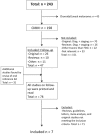Positron emission tomography in the follow-up of cutaneous malignant melanoma patients: a systematic review
- PMID: 24380042
- PMCID: PMC3867726
Positron emission tomography in the follow-up of cutaneous malignant melanoma patients: a systematic review
Abstract
Cutaneous malignant melanoma (CMM) has a high risk of dissemination to regional lymph nodes and visceral organs. Recurrences are most frequently seen within the first 2-3 years after initial treatment, but these patients have a life-long risk of relapse. The prognosis is highly dependent on lymph node involvement and distant metastases, accentuating the importance of close surveillance to identify disease progression at an early stage, and thereby detect recurrences amenable to treatment. Positron emission tomography (PET) has already been proven useful in the staging of CMM, but the utility of PET in follow-up programs for asymptomatic patients in high risk of relapse to detect systemic recurrences has yet to be investigated. We performed a systematic literature search in PUBMED, EMBASE and the Cochrane Controlled Trials Register, and identified 7 original studies on the diagnostic value of FDG-PET in the follow-up of CMM. Sensitivity, specificity, positive and negative predictive values were calculated to examine PET's diagnostic value in detecting relapse. The mean sensitivity of PET was 96% and the specificity was 92%. The positive and negative predictive values were, respectively, 92% and 95%. Overall, PET has a high diagnostic value and the many advantages of PET indicate utility in the routine follow-up program of CMM. However, the number of prospective studies of high quality is scarce, and as the use of PET and PET/CT is becoming more widespread and the technology is expensive, there is an urgent need for systematic assessment of the diagnostic value.
Keywords: FDG; Melanoma; PET; PET/CT; cancer; diagnostics; follow-up; skin cancer.
Figures
References
-
- Little EG, Eide MJ. Update on the current state of melanoma incidence. Dermatol Clin. 2012;30:355–361. - PubMed
-
- Balch CM, Gershenwald JE, Soong SJ, Thompson JF, Atkins MB, Byrd DR, Buzaid AC, Cochran AJ, Coit DG, Ding S, Eggermont AM, Flaherty KT, Gimotty PA, Kirkwood JM, McMasters KM, Mihm MC Jr, Morton DL, Ross MI, Sober AJ, Sondak VK. Final version of 2009 AJCC melanoma staging and classification. J. Clin. Oncol. 2009;27:6199–6206. - PMC - PubMed
-
- de Vries M, Speijers MJ, Bastiaannet E, Plukker JT, Brouwers AH, van Ginkel RJ, Suurmeijer AJ, Hoekstra HJ. Long-term follow-up reveals that ulceration and sentinel lymph node status are the strongest predictors for survival in patients with primary cutaneous melanoma. Eur J Surg Oncol. 2011;37:681–687. - PubMed
-
- Mooney MM, Kulas M, McKinley B, Michalek AM, Kraybill WG. Impact on survival by method of recurrence detection in stage I and II cutaneous melanoma. Ann Surg Oncol. 1998;5:54–63. - PubMed
-
- Leiter U, Buettner PG, Eigentler TK, Forschner A, Meier F, Garbe C. Is detection of melanoma metastasis during surveillance in an early phase of development associated with a survival benefit? Melanoma Res. 2010;20:240–246. - PubMed
Publication types
LinkOut - more resources
Full Text Sources
Other Literature Sources

